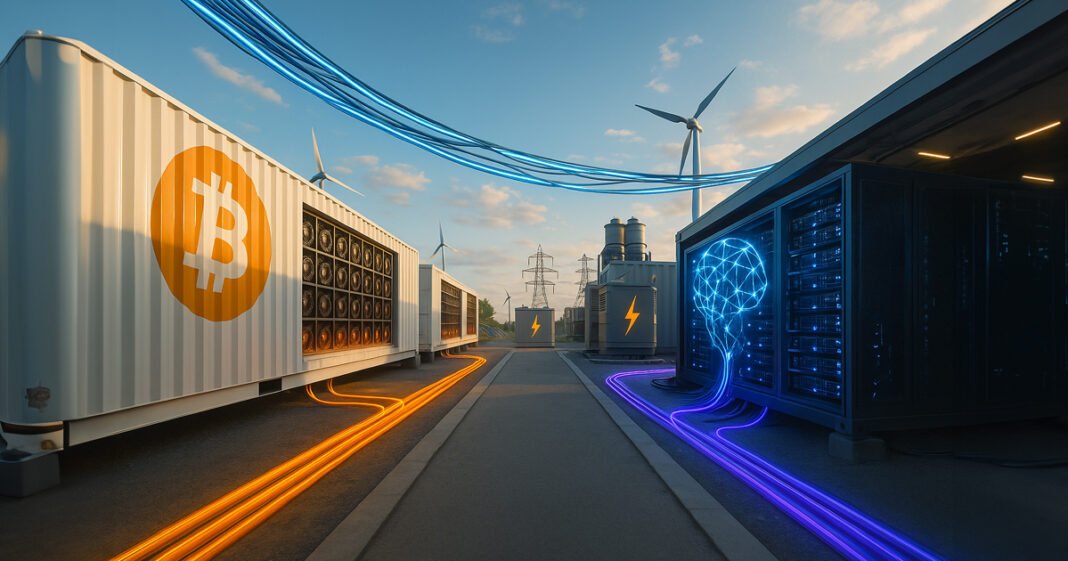The AI Colocation Gold Rush
From Hashes to Hyperscalers
The core premise is simple: the very infrastructure designed to power energy-intensive SHA-256 ASICs can generate significantly more revenue when redirected towards AI computation. Core Scientific, emerging from bankruptcy restructuring, has spearheaded this trend, committing a staggering 500 megawatts to CoreWeave in a 12-year deal worth $8.7 billion. Cipher Mining followed suit, securing a $3 billion, decade-long agreement with Fluidstack, backed by the formidable presence of Google. As we move into 2025, expect to see more major mining firms diversifying into AI hosting.
These lucrative contracts hinge on a fundamental calculation: the dollar-per-megawatt-hour yield is, in many cases, higher for AI workloads than for Bitcoin mining, especially in a post-halving environment. The traditional mining revenue model is intrinsically tied to the volatile hash price and Bitcoin’s spot price. In contrast, AI colocation offers predictable, contracted dollar revenue, offering a haven of stability amid the crypto market’s inherent uncertainty. This transition offers miners a hedge, a diversification strategy allowing them to shield from the price fluctuations that can make or break their margins.
The Security Budget Under Scrutiny
The implications for Bitcoin’s security budget are significant. Hashprice, the revenue miners earn per petahash per day, is the lifeblood of the network. A decline in hashprice can lead to miners shutting down operations or selling Bitcoin to cover expenses. The network’s security is directly proportional to the economic incentives for miners, consisting of block subsidies and transaction fees. The 2024 halving put considerable pressure on this budget, increasing its sensitivity to market fluctuations.
While transient fee spikes, such as those observed during the launch of the Runes protocol, demonstrate the potential for on-chain demand to boost miner revenue, these instances are often fleeting. Power costs, fixed in fiat, combined with Bitcoin-denominated revenue create a tight margin. At a hash price of $50 per petahash per day, even the most advanced mining fleets struggle to generate substantial profits. The difference between survival and prosperity is narrow, hinging on factors largely outside a miner’s control: Bitcoin price, network difficulty, and transaction fee velocity.
Read Also: Bitcoin’s Uncharacteristic Red October 2025: Unpacking Macro Factors and Market Resilience
AI: A Lifeline or a Gamble?
AI hosting presents itself as a compelling alternative. Unlike Bitcoin mining, which is susceptible to price volatility and network difficulty adjustments, AI colocation offers stable, dollar-denominated contracts spanning several years. This transforms the revenue structure from a speculative venture to an infrastructure-as-a-service model, providing a predictable and consistent income stream. The economics are compelling with Core Scientific’s CoreWeave deal implying a hosting fee of roughly $121 per kilowatt-month, while Cipher’s Fluidstack contract commands about $149 per kW-month.
Consider a hypothetical scenario: a 100-MW mining facility operating SHA-256 at a hash price of $75 per petahash per day and a power cost of $50 per MWh generates approximately $129 per megawatt-hour in cash margin, translating to roughly $11.3 million annually. The same facility leased to an AI tenant at $150 per kW per month yields a facility revenue intensity of approximately $174 per MWh. If the tenant shoulders the power costs, the operator retains most of this as margin, resulting in a significantly higher cash flow compared to traditional mining. For miners burdened with debt, this predictable cash flow can be crucial for securing financing and maintaining operations.
Strategic Implications and Future Outlook
Treasury Management and Network Effects
A shift towards AI hosting could have a significant impact on Bitcoin’s supply dynamics. Miners who generate substantial revenue from AI colocation have less incentive to sell their Bitcoin holdings to cover operational expenses. This reduces the downward pressure on Bitcoin’s price and allows miners to maintain coin-denominated treasuries, insulating them from market volatility. This reduction in miner selling pressure is a vital development for long-term price stability.
However, if a significant portion of the hashrate migrates to AI hosting and isn’t adequately replaced, the network’s hashrate will decline. This could increase the cost of attacking the Bitcoin network. Conversely, a lower network hashrate translates to a higher hash price for remaining miners, assuming constant Bitcoin price and fees. Miners who stay committed to SHA-256 mining stand to benefit from this increased profitability.
Winners, Losers, and Potential Pitfalls
Who stands to gain?
- Operators with access to cheap power.
- Miners with expandable grid interconnects.
- Firms with the capital to invest in new infrastructure.
- Companies who are proactive and early adopters.
What are the risks?
- Shifting GPU compute cycles can impact the desirability of contracts.
- Counterparty risk associated with smaller AI start-ups.
- Grid congestion and politics surrounding large power loads, particularly in Texas.
- Stranded interconnects as interconnect queues can delay monetisation.
The ultimate success of this diversification strategy hinges on a number of factors, including the evolution of the AI landscape, regulatory developments, and the ability of miners to effectively manage their power contracts and grid interconnects. We are already seeing firms such as Bitdeer, Iris Energy, TeraWulf and CleanSpark signalling their intention to move towards HPC (High Performance Compute).
Looking Ahead to 2026
In the coming year, key metrics to watch will include announcements of power purchase agreements, progress on ERCOT interconnect milestones, miner guidance on non-BTC revenue mix, and the fee velocity on the Bitcoin network. The ERCOT capacity reports will provide valuable insights into the scarcity of power in Texas, where much of the large-load action is concentrated. Interconnect capacity is likely to become the most critical constraint.
The strategic question isn’t whether miners become AI companies but how they allocate finite interconnect capacity, power contracts, and balance sheet resources between competing uses. Those that succeed will be able to navigate between SHA-256 operations and scaling AI hosting, adapting to market changes as they evolve. The future of Bitcoin mining is at a pivotal moment. Will it remain a single-use industry, or will it evolve into a multi-tenant power monetisation layer that secures a blockchain on the side?






